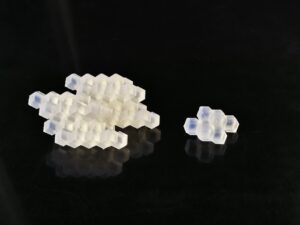Applicant
Prof. Dr. Jörg Arndt
Technische Hochschule Nürnberg Georg Simon Ohm
Wassertorstraße 10, 90489 Nürnberg
Project Summary
Only a few three-dimensional space-filling curves are known. The two notable examples are the Hilbert curve and the Peano curve. The borders for both are two-dimensional. However, the borders of almost all space-filling curves have a fractal dimension strictly greater than two.
The building blocks of these pieces of space with fractal boundaries are polycubes and their analogs comprised of rhombic dodecahedra of truncated octahedra.

A software for the parallel computation of all such polycubes of a given size was written. The main reason for parallelization is the great amount of RAM needed for the computation. The computation is split into many smaller processes that need no intercommunication. Each process needs roughly the same amount of RAM, typically a factor of 1/8 to 1/256 of the non-parallel search.
Interestingly, we only need less than one byte to finally store each polycube. Still, the number of polycubes is growing exponentially, so the resulting files get prohibitively large already for moderate numbers of constituent cubes.
References
Jörg Arndt, Julia Handl: Edge-covering plane-filling curves on grid colorings: a pedestrian approach, arXiv:2312.00654 [math.CO], (1-December- 2023), URL: https://arxiv.org/abs/2312.00654.

